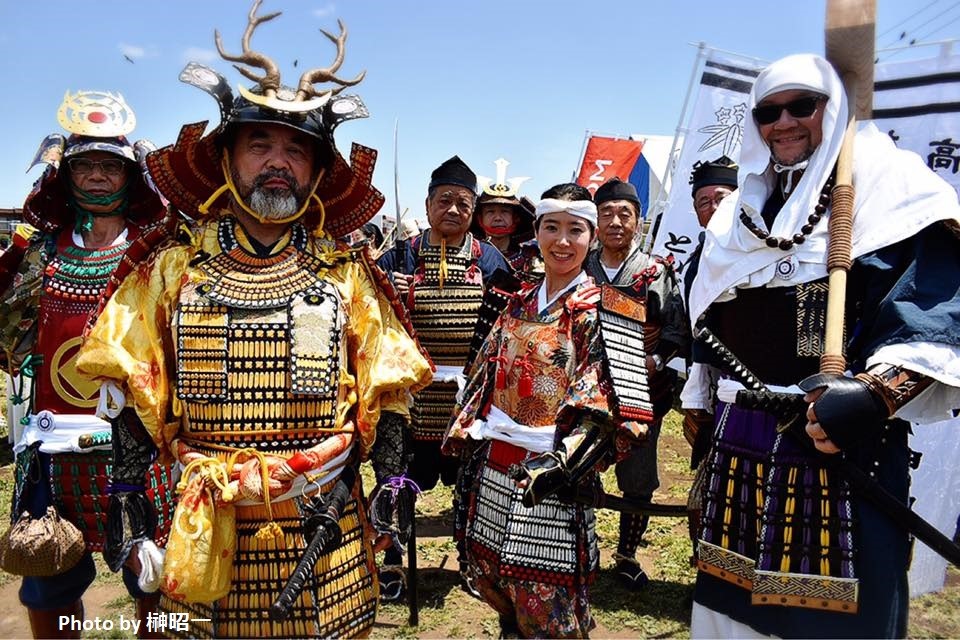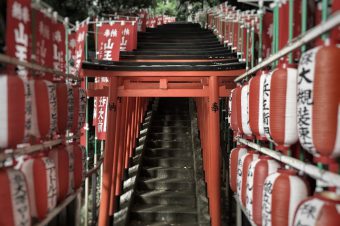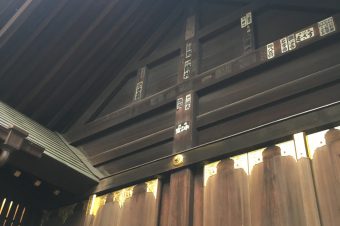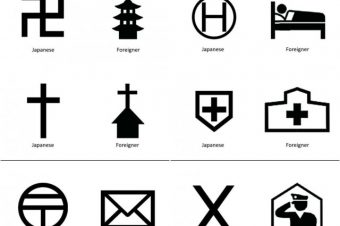
(Writing the column article about Nangu Taisha in Tarui reminded me I had promised to write about why I considered General Hanbei TAKENAKA to be the person who brought victory to Lord Ieyasu TOKUGAWA at the Battle of Sekigahara, fought almost 20 years after General Hanbei passed away. So, here goes…)
Guys, imagine yourself to be 21 years old, pudgy, perhaps not too popular with the ladies, and all of a sudden someone hands you the keys to a beautiful young 18-year-old girl nicknamed “The Fairest Beauty in All the Land.”
Gals, imagine yourself to be 18 years old, beautiful, and dreaming of meeting a dashing young Prince who whisks you off to his hilltop castle and the two of you live happily ever after. Except, because you actually happen to be a Princess already, you know your dreams don’t count for diddly-squat. Conversely, you know your fate is to be used as a pawn in a politically expedient marriage, very possibly becoming nothing more than a baby factory for some geezer older than your father and your body used solely to beget an heir. Your husband could then die in a couple years, once again leaving you to your fate of being used as a pawn in a politically expedient marriage… Not a pretty picture, is it?
Please stay with me, ladies. The fateful day arrives. It is your wedding day. You step out of your palanquin to meet for the very first time the man who will become your husband. Guess what!!! He’s not some old fart, but only 21 years old! He’s not just a Prince, he’s a King already! Of a very prosperous Kingdom, to boot! Well respected and loved by his subjects! He owns a hilltop castle! He’s a proven military genius! Okay, so he might be packing a few extra pounds, but at this point, who cares? WOO HOO!
The year is 1564. The young King is Lord Nagamasa AZAI. The young Princess is Lady O-Ichi ODA. All of the above is a true episode from history. (Except for the ages of the two involved, that is. Lord Nagamasa was 18 and Lady O-Ichi was 15 when the two were married. I took the liberty of adding three years in both cases to avoid reactions of “EEEW! Stat-rape!” In Japan at the time, girls were expected to become mothers by age 16, and an unmarried 18-year-old girl was pretty much considered to be on the shelf.)
As might be expected, it was love at first sight for the Lord and his new Lady. Lord Nagamasa became a loving husband and a doting father to a boy and three little girls. Lady O-Ichi became a passionately devoted wife and mother.
Unfortunately, though, their fate was not to live happily ever after. The two were violently separated in 1573 and thus were planted the seeds which culminated in a successful victory for Lord Ieyasu TOKUGAWA at the Battle of Sekigahara, fought in the year 1600.
There are two theories on why Lord Nagamasa and Lord Nobunaga ODA (Lady O-Ichi’s elder brother, whom arranged her wedding) became deadly enemies. Avoiding that controversy for now, suffice it to say even though Lord Nagamasa almost succeeded in defeating Lord Nobunaga, in the end Lord Nobunaga prevailed. Two very famous battles were fought between the forces of the two Lords, the Battle of Anekawa and the Siege of Odani Castle. In both battles, the brilliant military strategy of General Hanbei TAKENAKA (the subject of the “Can a feudal era General and famed military strategist act as a modern-day Cupid?” series) carried the day. You may recall General Hanbei worked as an advisor to Lord Hideyoshi TOYOTOMI. The battle of Anekawa was the first time Lord Hideyoshi led a major force into battle. Few period records of the battle exist so it is hard to separate fact from fiction, but one version has it Lord Hideyoshi oversaw the forces arrayed to protect Lord Nobunaga, and this was where General Hanbei proved his brilliance. This is probably true because an Azai samurai disguised himself, snuck into Lord Nobunaga’s headquarters and almost managed to take Lord Nobunaga’s head. Fortunately, either General Hanbei’s younger brother Kyuusaku or General Hanbei’s most famous retainer Yatari Fuwa saw through the disguise and killed the enemy samurai. At any rate, someone very close to General Hanbei managed to save Lord Nobunaga at the brink of death, so most likely Lord Hideyoshi was indeed in charge of the guard force.
At the Siege of Odani Castle (Lord Nagamasa’s hilltop castle) in 1573, the attacking force was commanded by Lord Hideyoshi, under orders from Lord Nobunaga. Once again General Hanbei’s strategy brought victory to Lord Hideyoshi. Lord Nagamasa committed seppuku (ritual suicide) and while Lady O-Ichi wanted to accompany her husband in death, Lord Nagamasa convinced her to escape the castle and save the lives of their three daughters. Lord Nagamasa’s son accompanied his father into death, however, as Lord Nobunaga would never have permitted Lord Nagamasa’s son to live anyway. Better an honorable death accompanying his father than to be hunted down and executed by Lord Nobunaga’s soldiers.
Once again Lady O-Ichi found herself as a mere tool used to cement political alliances, and approximately ten years later, during the factional intrigue which resulted after Lord Nobunaga’s assassination, she ended up becoming the wife of one of the former Lord Nobunaga’s best generals, Lord Katsuie SHIBATA, who was heading up one of the factions. Lord Katsuie was widower 25 years older than O-Ichi, plus barbaric in appearance and demeanor, it is said, but Beauty managed to tame the Beast. It appears Lord Katsuie became a loving husband and a devoted father to his three stepdaughters. Lady O-Ichi loved her new husband and his two adopted sons as well, it is said. However, the family’s happiness was fleeting.
Remember Lord Hideyoshi, the man who drove O-Ichi’s first husband to death? Well, Lord Hideyoshi was heading up the rival faction, and ended up besieging Lord Katsuie at Kitanosho Castle. Lord Katsuie was defeated and decided to commit suicide by blowing himself and his castle up. Again, Lady O-Ichi’s husband begged her not to follow him into death, but this time Lady O-Ichi put her foot firmly down. She was a samurai lady, after all, and it was her duty to follow her husband to death. Lady O-Ichi arranged for the safe retreat of her three daughters, imploring Lord Hideyoshi to become their adoptive father/protector, then followed her husband into death.
We now shift our focus to Lady O-Ichi’s oldest daughter, Cha-cha, now the stepdaughter of Lord Hideyoshi, the man who forced both her biological father and stepfather to die. Lord Hideyoshi was also noted for amassing a collection of beautiful women to serve as secondary wives and concubines. Some were even taken as spoils of war. Despite all this help, however, Hideyoshi had not yet managed to father his own child.
Therefore, with Lord Hideyoshi being the quintessential dirty old man, it was only a short matter of time before he married his adopted daughter. Cha-cha became one of Lord Hideyoshi’s secondary wives and was bestowed the name Lady Yodo. Cha-cha played her cards well, however, and managed to wrap Hideyoshi around her little finger. Hideyoshi’s first and primary wife, Lady Nene, was eclipsed and sent off to live in another castle. In 1593, Cha-cha gave birth to Hideyori, Hideyoshi’s first child to survive infancy (an earlier child died in infancy).
Lord Hideyoshi was elated. Despite persistent rumors Hideyori was really someone else’s child, mainly because Hideyoshi was in Kyushu running his Korean campaign about the time Hideyori was conceived, Hideyoshi became a doting father and did everything possible to ensure Hideyori would ascend to power after Hideyoshi passed away. This include wiping out entire branches of his extended family. Lord Hideyoshi died in 1598, leaving his six-year-old son as appointed heir but in the care of five regents and five magistrates.
So, you may be wondering what does all of this have to do with the price of tea in China. Please be patient. Readers of this column may remember I credit General Hanbei with bringing about victory for Lord Ieyasu at the Battle of Sekigahara, even though the actual battle took place 20 years after General Hanbei’s death. Now, once again it is time to go back in history, this time following the life of General Nagamasa KURODA. (To avoid confusion with Lord Nagamasa AZAI or Lord Kanbei KURODA, I will hereafter refer to General Nagamasa Kuroda as General NK.)
The following is an excerpt from Episode 6 of the “Legendary General” series. Please keep in mind General Nagamasa in this excerpt refers to General Nagamasa KURODA:
The Battle of Sekighara determined the fate of Lord Ieyasu Tokugawa. It was a gamble for him to rule “All Under Heaven.” As it turned out, the opening of the battle found Lord Ieyasu in a very disadvantageous position. The forces of General Mitsunari occupied all the high ground surrounding Sekigahara. Lord Ieyasu’s main battle force, loyal only to him and under the command of his son Hidetada, was hung up battling the forces of Sanada at Ueda Castle in today’s Nagano Prefecture. The forces Lord Ieyasu had with him to start the battle were mostly former generals and armies serving Lord Hideyoshi Toyotomi, and were of questionable allegiance. Any modern military tactician, looking at the disposition of the opposing forces and knowing Lord Ieyasu’s primary battle force was not available for combat that day, would conclude victory was General Mitsunari’s for the taking. However, in my opinion, even during this battle fought long after General Hanbei’s death, General Hanbei delivered via proxy a deciding victory to Lord Ieyasu. A battle which everyone thought would last for months was decided in a little over six hours. This is truly remarkable.
While the Battle of Sekigahara I will cover in later issues of this column, to understand how my personal tale unfolds, one must understand the pivotal role General Hanbei played in the Battle of Sekigahara, fought 20 years after his death. For that we must again travel back in time, to 1578. While I have earlier mentioned General Hanbei was famous as a military strategist to Lord Hideyoshi Toyotomi, there was also another famous military strategist serving Lord Hideyoshi, being so assigned by Lord Nobunaga Oda. That was General Kanbei Kuroda.
(Hereafter referred to as General Kuroda to avoid confusion with General Hanbei.) As was common during those times, when General Kuroda first began service with Lord Nobunaga, General Kuroda offered up his son Shojumaru to be a hostage. During this era, hostages were just as important as politically arranged marriages to ensure loyalty. In 1578 however, some of Lord Nobunaga’s generals began to mutiny. The central figure was General Murashige Araki. General Kuroda took it upon himself to travel to General Araki’s castle in Settsu (present day Settsu city in Osaka Prefecture) to convince General Araki to return to the Nobunaga fold. General Araki ended up throwing General Kuroda in an underground dungeon and let him languish for over a year. Lord Nobunaga, after receiving no word from General Kuroda, was convinced General Kuroda had also defected, and ordered General Hanbei to execute the hostage Shojumaru. General Hanbei took it upon himself to hide Shojumaru instead, and entrusted Shojumaru’s care to one of his most trusted retainers, Yatari Fuwa. Reunited with his father after General Kuroda was rescued from the dungeon (which was after General Hanbei’s death), Shojumaru safely reached adulthood and took the name of Nagamasa. General Nagamasa later entered the service of Lord Ieyasu Tokugawa, and fought for Lord Ieyasu at the battle of Sekigahara. This was the general who participated in the Battle of Sekigahara wearing General Hanbei’s coveted Ichi-no-Tani helmet. General Nagamasa was, in my opinion, absolutely crucial to bringing about victory for Lord Ieyasu. While his exploits before and during the battle will be the subject of a later column, suffice it to say General Nagamasa was the most highly rewarded amongst Lord Ieyasu’s generals. Lord Ieyasu of course recognized the massive contribution made by General Nagamasa.
So, what? There’s still no connection to Lady O-Ichi. Well, the missing critical piece of information is this: both Ieyasu and Mitsunari claimed to be fighting on Hideyori Toyotomi’s behalf. Ieyasu was a Regent and Mitsunari was a Magistrate, both so appointed by Lord Hideyoshi. Because Ieyasu’s main battle force was hung up, the Battle of Sekigahara was a battle fought amongst former Hideyoshi retainers. The tale of O-Ichi is crucial to understanding why these retainers spilt up and fought each other.
Let’s go upstream in time again, to when Shoujumaru was a hostage. He was placed in the care of Lady Nene, Lord Hideyoshi’s primary wife. Lady Nene was placed in charge of most of the Nobunaga hostages, so Shoujumaru found himself with a lot of playmates in the same boat. Their fathers were Generals and Lords serving Lord Nobunaga, and some of these kids grew up to also become Generals and Lords serving Lord Hideyoshi after Nobunaga was assassinated. Key examples are Masanori FUKUSHIMA, Kiyomasa KATO, Tadaoki HOSOKAWA, Hideaki KOBAYAKAWA (who was Lady Nene’s nephew and Hideyoshi’s adopted son, not a hostage) and of course General NK himself. They formed a second generation of warrior leaders serving under Lord Hideyoshi. For sake of simplicity, we’ll call this group “Nene’s Boys.” Lord Ieyasu was wise enough to act as a mentor to Nene’s Boys.
In contrast, Lord Mitsunari, and his primary ally at Sekigahara, Lord Ohishi, were not Nene’s Boys. They were recruited directly by Lord Hideyoshi himself. While Nene’s Boys mostly served on the battlefield, these two were primarily staff officers.
So here we have Rivalry One: combat officers vs. staffies.
Lady Nene probably didn’t for a moment believe Hideyoshi was actually Hideyori’s biological father (Interestingly, one popular theory is Mitsunari was actually Hideyori’s biological father). So, having been eclipsed by Lady Yodo and then banished to a distant location, Lady Nene had no reason whatsoever to support the Yodo/Hideyori faction. Plus, all of Nene’s Boys felt sorry for the lady whom had been their surrogate mother, and paid more attention to her wishes than to those of Lady Yodo. In contrast, Lord Mitsunari and Ohishi had no reason to support Lady Nene and instead submitted to Lady Yodo’s wishes.
So, here we have Rivalry Two: Nene faction vs. Yodo faction.
These two rivalries would play pivotal roles at the Battle of Sekigahara.
Now, let’s look at two personal conflicts.
Lord Hideaki KOBAYAKAWA was originally Hideyoshi’s adopted son and was due to inherit the throne after Hideyoshi’s death. The birth of Hideyori changed all of that, however, and Hideaki found himself whisked off to become the adopted son of the KOBAYAKAWA clan. Additionally, after being accused by Lord Hideyoshi of recklessness in the Korean campaign (thanks to an exaggerated report filed by Lord Mitsunari), Lord Kobayakawa found himself stripped of a considerable chunk of territory. Only through the intervention of Lord Ieyasu was Lord Kobayakawa able to regain a lot of his lost territories and status.
Lord Hiroie KIKKAWA wasn’t one of Nene’s Boys, but was with them fighting valiantly in Korea when Lord Mitsunari swung by on an inspection visit. As Lord Mitsunari wanted the Korean conflict to end, he sent pessimistic status reports back to Lord Hideyoshi in northwestern Kyushu, basically understating the prowess of the various Lords engaged in fighting on the peninsula. Lord Hiroie was one of those adversely affected, and therefore had a major axe to grind with Lord Mitsunari.
After Lord Hideyoshi died and the second Korean campaign came to an abrupt halt, Nene’s Boys took it upon themselves to go after Lord Mitsunari with a vengeance. This was halted by Lord Ieyasu, who actually gave temporary refuge to Lord Mitsunari, with the proviso Mitsunari quietly retire to his castle on the shores of Lake Biwa.
Lord Ieyasu patiently waited until Lord Maeda, the senior Regent, died, then set about consolidating his position. He accused the Uesugi clan of fortifying their fiefdom without permission, begat an insulting letter in response, and used it as an excuse to raise troops and set off on a punitive mission to the Uesugi fiefdom in northeastern Japan. While all this was going on, Lord Ieyasu also arranged for Lord NK to marry his adopted daughter. Lord Ieyasu was already Lord NK’s mentor, but now became his father-in-law as well.
Once Lord Ieyasu left on this mission, Lord Mitsunari issued a letter outlining Lord Ieyasu’s many violations of trust against Hideyori Toyotomi and raised troops to combat Lord Ieyasu.
Lord NK of course took part in the Uesugi mission, along with most of the other Nene’s Boys. (Note: It is important to mention here neither Lord Hideaki nor Lord Hiroie were present.) When word of Lord Mitsunari’s offensive reached the Ieyasu side, Lord Ieyasu was in Oyama, currently part of Tochigi Prefecture. Lord Ieyasu decided to hold a Battle Planning Conference to figure out what to do. Keep in mind a lot of his generals were former Hideyoshi generals, and their loyalty was in doubt now that Lord Mitsunari claimed to be acting on behalf of Hideyori. Lord NK convinced the leader of Nene’s Boys, Lord Masanori FUKUSHIMA, to speak out at the Oyama Battle Planning Conference stating he (Fukushima) strongly felt Lord Ieyasu was in the right and it was Lord Mitsunari who was planning a coup d’état instead. As Fukushima was the erstwhile leader of Nene’s Boys, all the others in the group followed suit and Ieyasu declared he was going to topple Lord Mitsunari to protect the young Hideyori. Such was the result of the famous Oyama Conference, held on July 25th (lunar calendar), approximately two months before the Battle of Sekigahara.
Fast forward to September 14th (Lunar Calendar). Lord Mitsunari, after his allies suffered defeats at Kiyosu Castle, Gifu Castle, and the Kiso riverbank, decided to hole up in Ohgaki Castle. His strategy was to drag the encounter out for about a month, after which time Lord Terumoto MOHRI (aka Mohri the Elder), overall in charge of the entire anti-Ieyasu campaign, would set out from Osaka Castle and bring young Hideyori with him to the battlefield. Hideyori’s presence with the forces of Mitsunari would prove once and for all Lord Mitsunari held the high moral ground. The thinking was at this point Nene’s Boys would be forced to turn against Lord Ieyasu.
Lord Ieyasu had seen this sort of strategy before, when he and Lord Hideyoshi were duking it out at the Battle of Komaki/Nagakude in 1584. Ieyasu therefore needed to defeat Mitsunari as soon as possible. So, Lord Ieyasu initiated a deception plan to draw Lord Mitsunari out of the castle. Lord Ieyasu claimed he was going to bypass the hard-to-attack Ohgaki Castle and instead attack Mitsunari’s very own castle at Sawayama, on the banks of Lake Biwa. Lord Ieyasu then “allowed” that information to leak to Mitsunari’s headquarters. The plan worked beautifully. Late in the evening of the 14th, Mitsunari’s forces left Ogaki to occupy previously prepared encampments in the Sekigahara area, to block Ieyasu’s advance towards Sawayama.
Mitsunari may have mainly been a staff type, but he had some battlefield experience and his strategy and tactics for Sekigahara were brilliant. Looking at force deployment at the start of the battle, most military tacticians would conclude Lord Mitsunari won the battle. However, what Mitsunari didn’t understand were the personal dynamics motivating his various generals which trumped any loyalty they felt towards Hideyori. The chickens Mitsunari had freed during the Korean Campaign came home to roost with a vengeance.
Plus, it didn’t help matted when Lord Mitsunari, in preparing for the anti-Tokugawa campaign, rounded up all the Lords’ wives whom were living in Osaka and Kyoto at the time to use them as hostages to ensure “loyalty.” There are two famous episodes associated with this event, one happy and one sad. In the happy episode, Lord NK’s father, the famous Lord Kanbei KURODA, anticipated such things would happen and sent some of his most trusted warriors to rescue Lord NK’s mother and wife, then sneak them out of Osaka. In the sad episode, Lord Tadaoki HOSOKAWA’s wife, Lady Gracia (a Christian) determined she would not become a hostage and thus hamper her husband. However, as a Christian she considered suicide a grave sin and therefore ordered one of her retainers to kill her instead.
Okay, back to the Sekigahara field of battle. Imagine if you will a “upside down Y” shaped valley. Ieyasu established his headquarters encampment in the crotch of the Y, facing the single leg which was the narrow pass leading to Lake Biwa. The hills to his front/right and front/left were occupied by Mitsunari forces, with Mitsunari himself on the right and Lord Hideaki (part of the Mitsunari forces) leading about 11000 of his own troops on the left. Occupying the hill immediately behind Ieyasu was Lord Hiroie, assigned to lead the combined charge of consisting of his, General Hidemoto MOHRI (aka Mohri the Younger)’s, Lord CHOHSOKABE’s and ANKOKUJI-EKEI’s troops. In all, about 30000 troops were amassed on this hilltop behind Ieyasu, with Lord Hiroie’s troops in the lead.
The battle started early morning on the 15th, just as soon as the morning fog cleared. Ieyasu was having a hard time. However, neither Lord Hideaki nor General Hiroie moved an inch. Given the battle rules of the time, the Lords and Generals positioned behind General Hiroie couldn’t deploy their troops until the General assigned to lead the charge moved. At first, Hiroie claimed he was waiting for the fog to clear. After the fog cleared, and Hiroie still refused to move, Lord CHOHSOKABE was incensed and angrily asked why. Mohri the Younger claimed Hiroie couldn’t move because Hiroie was feeding his troops. (It is surmised Mohri the Younger really did NOT have his heart set on fighting as he felt Mohri the Elder was hoping Mohri the Younger would die on the battlefield, thereby neatly settling a factional conflict brewing within the Mohri Clan.) And so, none of the 30000 troops amassed on this hilltop participated in the battle. Ieyasu was safe to move without having to fear an attack from the rear. What Mitsunari failed to understand, in my opinion, was this: the MOHRI and KIKKAWA clans had been bluffed and fooled by Hideyoshi at the Battle of Bicchu-Takamatsu (1582). Their loyalty to Hideyoshi was entirely out of respect for Hideyoshi’s power. Once that power started to fall apart, these two started thinking of their own interests instead.
Additionally, a few days before the battle, Lord NK, having fought with Lord Hiroie in Korea and knowing Hiroie bore a grudge against Mitsunari, sent Hiroie a letter pointing out a victory for Ieyasu would better serve Hiroie than a victory for Mitsunari. This letter pretty much sealed the deal for Hiroie, hence his refusal to partake of the battle and instead leave 30000 troops penned up on the hilltop. Chalk up a major coup for Lord NK! Lord Ieyasu no longer had to worry about being attacked from the rear.
Next, how about Lord Hideaki KOBAYAKAWA? Before the battle, he received letters from both Mitsunari and Ieyasu, promising territories and political status in return for loyalty. That was to be expected and probably equally weighed. However, Lord NK also sent his childhood friend Hideaki a letter, imploring Hideaki to consider a victory for which side would make Lady Nene, his surrogate mother, happy. Lord Hideaki nominally participated in the battle as part of Mitsunari’s forces. Having occupied a commanding position on a hilltop overlooking the battlefield, Hideaki then refused to move. One popular theory has it Hideaki was torn as to which side to support, and it took Lord Ieyasu to lose his temper, order a volley of cannon (or musket) fire to be fired in Hideaki’s general direction to prod Hideaki into action. Personally, I think Hideaki knew all along he would become a turncoat and attack Mitsunari forces, but was merely biding his time to make the best attack. At any rate, about four hours into the battle, Hideaki suddenly attacked the forces of Lord Ohishi, Mitsunari’s principal ally and advisor, which were at the base of the hill. Seeing this, and knowing now Ieyasu would win the battle, two other Mitsunari allies suddenly switched sides and start attacking Lord Ohishi as well. Chalk up a second major coup for Lord NK! Lord Ieyasu no longer had to worry about being attacked on his left flank.
Instead of having to defend against attacks from three directions, Lord Ieyasu was able to concentrate all of his army on a frontal attack on Lord Mitsunari and the forces immediately surrounding Mitsunari. And, guess where Lord NK was positioned? Right in front of Lord Mitsunari, and leading a joint force of Kuroda troops and troops belonging to his principal ally, General Shiekado Takenaka (General Hanbei’s son). The fighting was tough but somehow Lord NK managed to prevail against superior numbers, and when Hideaki betrayed his trust, the esprit de corps of the various Mitsunari generals crumbled and Lord NK was able to win in his sector. Chalk up a third major coup for Lord NK!
For the actions outlined above, Lord NK was the most highly rewarded amongst all of Ieyasu’s generals, and was given the fiefdom which included the city of Hakata, present day Fukuoka.
Remember, had it not been for General Hanbei TAKENAKA risking his own life by defying Lord Nobunaga to hide the young Shojumaru instead of executing the child, Lord NK would never have been at the Battle of Sekigahara. Lord Ieyasu might have been fighting in three directions instead of being able to concentrate his forces in one direction. Considering the battle was tough for the Ieyasu forces until Lord Hideaki attacked Lord Ohishi, Ieyasu might have lost the battle and Japan would have experienced a very different history.
In conclusion, all this is why I believe General Hanbei TAKENAKA delivered via proxy, in the form of Lord NK, a resounding victory for Lord Ieyasu TOKUGAWA, thereby setting the stage for the arrival of an era of peace spanning more than 250 years.
Postscript: This tale started with Lord Nagamasa AZAI and Lady O-Ichi. While in patriarchal Japan, Lord Nagamasa’s formal bloodline ended when he and his only son committed seppuku, in actuality his and Lady O-Ichi’s bloodline permeated the highest levels of Japanese society. Lady O-Ichi’s youngest daughter became the wife of the second TOKUGAWA Shogun, Lord Hidetada, and then became the mother of the third Shogun, Lord Iemitsu, and then the mother of a girl named Masako who would later marry Emperor Go-Mizunoo. So, let’s see, that makes Lord Nagamasa and Lady O-Ichi the grandparents of one Shogun, the great grandparents of another Shogun, and the great grandparents of an Empress. Pretty impressive, if you ask me. Nagamasa and O-Ichi must be pleased.
(Disclaimer: There are probably some factual/historical errors in the above, or differing versions of causes for the same events, etc. Please keep in mind I am neither a historian or an academic. Just some guy whom happens to like this kind of stuff and has watched too many historical documentaries, samurai dramas, etc. Your forgiveness is very much appreciated.)





